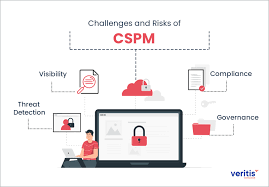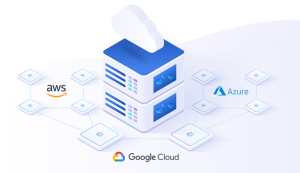Most businesses or companies store large amounts of data in the cloud. And all important information can be exposed if there is a misconfiguration in your cloud-based content.
That’s why you need to implement Cloud Security Posture Management. These tools minimize misconfiguration issues and allow you to detect cyber threats in your network. Article What Is Cloud Security Posture Management (CSPM)? will help you understand these concepts and how they work.
Contents
What is Cloud Security Posture Management?
Built by Gartner, Cloud Security Posture Management (CSPM) is the act of continuously improving your cloud security to limit your chances of being attacked by cybercriminals.
Its primary roles are to detect misconfiguration anomalies in the system and provide compliance assurance in the cloud.
CSPM is deployed on cloud systems such as Infrastructure as a Service (IaaS), Software as a Service (Saas), and Platform as a Service (PaaS). So what do those mean?
Infrastructure as a Service: IaaS is a type of cloud computing that provides virtualized computing resources on the internet.
Software as a Service: SaaS are workflow tools that allow users to host and manage their operations in the cloud.
Platform as a Service: PaaS is a complete development and deployment environment in the cloud with resources that allow you to create everything from simple cloud-based applications to enterprise applications that support complex cloud support.
Some of these CSPM tools warn your cloud environment to remediate a security risk. More advanced ones address cyber threats automatically with the use of Robotic Process Automation (RPA).
Why is cloud security posture management important?
CSPM is about data management and security. It ensures that your cloud-based data has a permissive environment without unauthorized access or changes to compromise it. This is key, especially in today’s volatile cyberspace. Data breaches are common and are often caused by errors related to cloud misconfiguration.
Cloud-based systems provide a dynamic work environment for your organization, enable collaboration between employees, and serve as a resource for networking. However, it is up to you and your IT professionals to see that they are in good shape for optimal performance.
CSPM tools build on the foundation of older cloud-based security frameworks to provide full security for your data stored in the cloud. With CSPM, you can automatically track activities within those services. And when a threat is detected, you will receive an alert.
How does CSPM work?
Although CSPM is relatively new, it has proven to be effective in creating a more secure environment for cloud-based services. From detecting cyber threats to launching protection mechanisms, it assures you that your cloud-based and cloud-native applications are not threatened.

1. Manage and fix misconfigurations
CSPM tools are effective in making your cloud environment risk-free. They test the security of your applications by comparing their configurations with industry benchmarks. And then they proceed to identify and correct existing violations.
Time is of the essence in cybersecurity. Security issues like port opening, misconfiguration, and unauthorized modification expose your cloud resources to cyberattacks. But CSPM solutions will fix vulnerabilities before cybercriminals take advantage of them.
CSPM tools also monitor your cloud storage to ensure that the right permissions are granted to the public and that no sensitive data is leaked. Users can only interact with your network based on the level of access granted to them. They also make provisions that allow database instances to be used for encryption and backup.
2. DevSecOps Integration
CSPM creates synergy that helps your organization reduce overall costs and remove the complexity of using multi-cloud accounts and services. It provides centralized control and visibility in the cloud environment.
Managing your cloud assets in a single platform gives your security capabilities and DevOps teams a definite path to follow. Since they have full visibility and control over your cloud environment, it’s easier for them to prevent content from getting into your system.
Interestingly, you can also merge your organization’s CSPM solutions with Security Information and Events Management (SIEM) tools for more insight into policy violations and wrong configuration.
3. Continuous threat detection
CSPM tools have a systematic way to detect network threats and manage them at the development stage to prevent potential attacks. Based on their reviews of apps, they focus on more vulnerable areas. Once detected, malicious code is prevented from reaching the production stage.
The cloud environment is continuously checked for suspicious activities and traces of unauthorized access.
Responses against cyberthreats are more effective when implemented early enough, before threats gain momentum. With continuous detection, your CSPM solution will deal directly with threats, leaving no room for escalation.
4. Discovery and Visibility
Gain visibility into your cloud infrastructure and security configuration with CSPM. You have a single source on your cloud environment, allowing you to automatically discover the network activity, misconfiguration, and security going on there.
CSPM features allow them to perform several roles in the security of your applications. Suffice it to say, the whole goal of having CSPM tools is defeated if they fail to perform the following functions.
– Discover and correct cloud environment misconfigurations.
– Monitor account permissions for misconfigurations, monitor storage pools, encryption, and compliance risks.
– Determine the current configuration status of your network security applications.
– Maintain best practices documentation for various cloud configurations and services.
– Prevent data leakage.
– Analyze data about interactions in cloud content for prediction.
– Evaluate new properties to ensure that they comply with established policies and regulations.
– Minimize insider accidents that can lead to data breaches.
Secure your cloud assets with CSPM
Since cloud assets are accessed remotely, they are a target for cybercriminals. If authorized users can gain access, they can too.

No matter how determined you are to protect your cloud-based assets, you cannot monitor them 24/7. Besides cultivating healthy web application methods, you need to adopt a system that can pull its weight even if you drop the ball.
Benefits of Cloud Security Posture Management
There are two types of risk: intentional and unintentional. Most cloud security programs focus on malicious insider and outsider attacks. However, unintentional mistakes, such as exposing sensitive data to the public in an S3 bucket, can cause great damage.
Cloud Security Posture Management works to prevent those accidental vulnerabilities by providing unified visibility across multi-cloud environments. That instead of having to test multiple dashboards and normalize data from multiple vendors. Misconfiguration is automatically prevented and value creation time is accelerated during use.
CSPM also eases the burden of alerts as alerts go through one system instead of the usual six or more and false alarms are minimized through the use of artificial intelligence. This in turn improves the productivity of the system’s security operations center (SOC).
Because CSPMs continuously monitor and evaluate the environment for compliance with compliance policies. When a discrepancy is detected, corrective action can automatically occur. And of course, CSPM can detect potential threats through continuous scanning of the entire infrastructure, and faster detection means shorter remediation times.
Hope the article What Is Cloud Security Posture Management (CSPM)? will provide you with useful information
Conclusion: So above is the What Is Cloud Security Posture Management (CSPM)? article. Hopefully with this article you can help you in life, always follow and read our good articles on the website: Doshared.com




